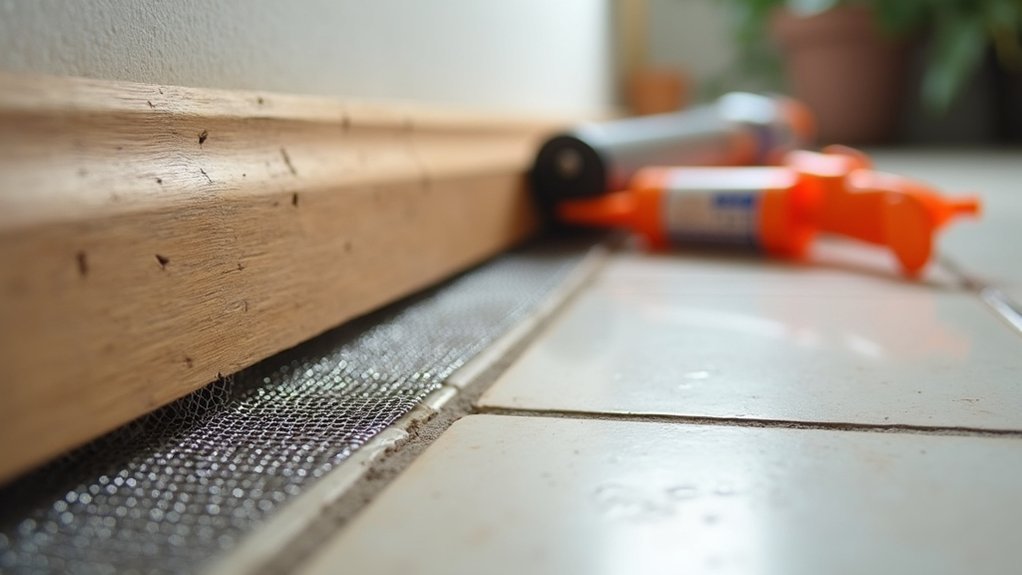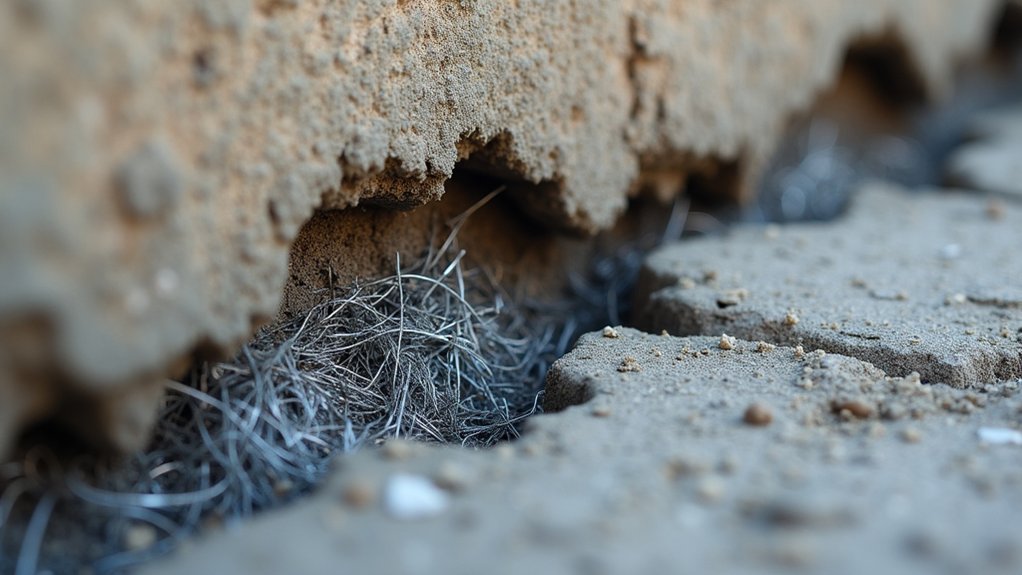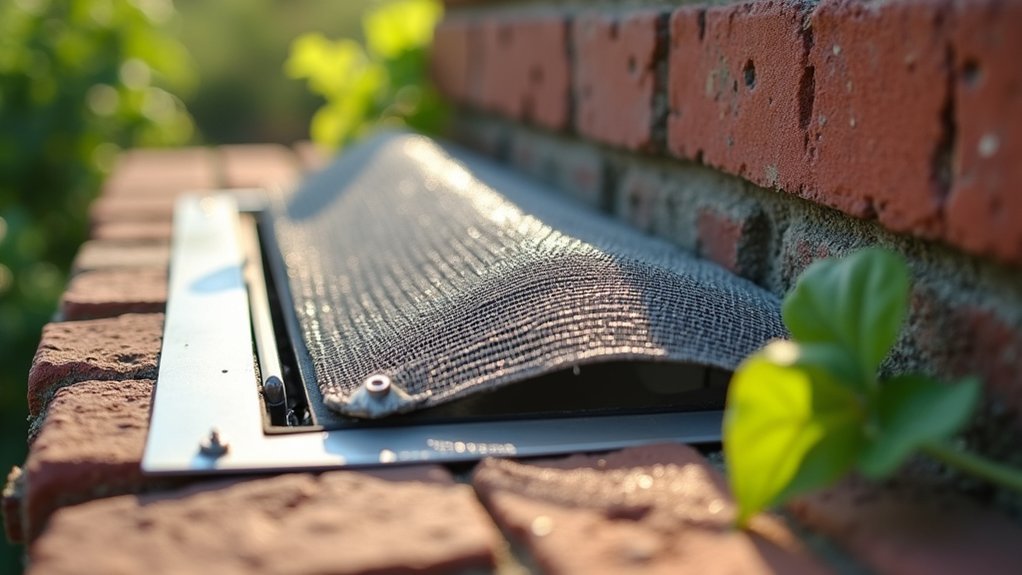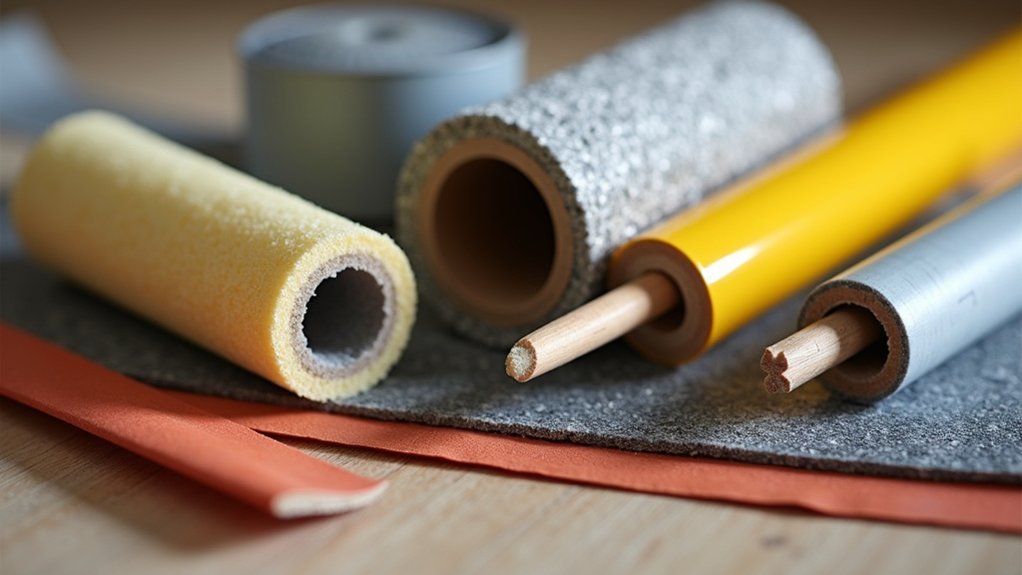To seal mouse entry points effectively, inspect your home’s foundation, utility penetrations, and weatherstripping for gaps larger than 1/4 inch. Pack these openings with steel wool and cover with silicone caulk for durability. Use hardware cloth for vents, secure weatherstripping on doors, and protect cabinets with mesh barriers. Apply expanding foam in large gaps, always reinforced with metal mesh. Don’t forget to add peppermint oil-soaked cotton balls as a secondary deterrent. These proven techniques will keep your home rodent-free.
Identifying Common Mouse Entry Points in Your Home

Because mice can squeeze through openings as small as 1/4 inch, protecting your home requires a thorough understanding of their potential access points.
Start by inspecting your foundation for cracks and gaps around doors, especially garage doors where weatherstripping may have been gnawed away.
Begin your mouse-proofing at the foundation level, checking for cracks and damaged weatherstripping around garage doors.
Don’t overlook high-level entry points in attics and crawl spaces, particularly where different materials meet at the roofline or where ventilation screens have deteriorated.
Your kitchen deserves special attention – check around cabinets and behind appliances for small holes and activity signs, as these areas frequently attract mice.
Remember to examine all utility penetrations where pipes and cables enter your home.
These often-forgotten spots provide ideal pathways for mice to access your living spaces.
Identifying these entry points is the essential first step before you can effectively seal gaps.
Essential Tools and Materials for DIY Mouse-Proofing
When starting on a mouse-proofing project, you’ll need to arm yourself with the right tools and materials to secure lasting results. Essential tools include a caulk gun, utility knife, and wire cutters for precise application and trimming of exclusion materials.
For effective barriers against rodent gnawing, use stainless steel fabric or copper mesh—these materials resist mice teeth better than alternatives. Seal gaps using high-quality silicone caulk, which remains flexible while providing durable protection.
For indoor use, steel wool works exceptionally well for plugging small holes since mice can’t chew through it.
When addressing larger openings, use spray foam as backing, but always cover it with metal mesh for complete mouse-proofing. This combination approach guarantees that even determined rodents won’t find their way back into your home.
Sealing Foundation Cracks and Wall Gaps With Steel Wool

Steel wool creates an impenetrable barrier against mice when you firmly pack it into foundation cracks and wall gaps.
You’ll need to cover the wool with caulk or another sealant to prevent moisture damage and guarantee long-term effectiveness.
Check your sealed areas every few months, replacing any rusted wool to maintain continuous protection against these persistent pests.
Proper Steel Wool Application
Three essential steps make steel wool one of the most effective barriers against determined mice. First, you’ll need to tightly pack the steel wool into all gaps larger than 1/4 inch to prevent rodents from pushing it out. Second, apply a layer of caulk over the steel wool to seal gaps completely and create a more permanent barrier against mouse entry points.
| Application Step | Materials Needed | Key Considerations |
|---|---|---|
| Gap Preparation | Gloves, Flashlight | Remove debris before application |
| Steel Wool Insertion | Stainless steel wool | Pack tightly, filling entire space |
| Sealing Application | Caulk, Caulking gun | Cover completely to prevent moisture |
Remember to inspect your barriers regularly as moisture can cause corrosion in regular steel wool. For lasting protection, invest in stainless steel wool which resists rust and maintains its integrity longer.
Long-Term Sealing Success
To achieve lasting protection against persistent rodents, you’ll need to properly seal foundation cracks and wall gaps with a combination of steel wool and weatherproof sealants.
Start by stuffing steel wool into holes larger than 1/4 inch, which prevents mice from getting through since they can’t chew through this material.
For foundation cracks, apply steel wool as backing before adding high-quality exterior caulk to create a durable barrier. This combination approach effectively blocks common entry points while resisting environmental damage.
Don’t forget to regularly inspect your sealing work for new vulnerabilities. Mice are resourceful and will exploit any weakness in your defenses.
If you’re dealing with extensive damage or hard-to-reach areas, don’t hesitate to seek professional help—their expertise guarantees thorough protection against these persistent pests.
Using Caulk to Block Tiny Openings Around Pipes and Utilities
Mice can easily squeeze through minuscule openings around utility lines and pipes, making these areas prime entry points for unwanted rodent guests.
To effectively seal your home against these persistent pests, high-quality silicone caulk offers an ideal solution for small gaps, as it’s resistant to rodent chewing and provides long-lasting protection.
Before applying caulk to potential entry points, follow these essential steps:
- Clean and dry all surfaces thoroughly to guarantee proper adhesion.
- Insert backer rod material first when filling gaps larger than 1/4 inch.
- Apply silicone caulk generously, smoothing it with a damp finger for complete coverage.
Remember to inspect your caulked areas regularly, as ongoing maintenance guarantees continued protection against rodent intrusions.
Hardware Cloth Installation for Vents and Larger Openings

When installing hardware cloth to rodent-proof your vents and larger openings, always select mesh with openings no larger than 1/4 inch to prevent even the smallest mice from squeezing through.
Cut the sturdy, welded wire mesh to extend at least one inch beyond the edges of the opening you’re covering for maximum protection.
Secure the hardware cloth firmly in place using screws rather than staples, as this creates a more durable barrier that mice can’t easily dislodge or gnaw around.
Proper Mesh Selection
Many homeowners overlook the critical importance of selecting appropriate mesh materials when securing vents and larger openings against mice. For effective prevention, you’ll need hardware cloth with a mesh size of 1/4 inch or smaller.
Always choose galvanized steel versions that resist rusting and withstand rodents’ persistent chewing attempts.
When installing your mesh barriers, follow these key steps:
- Cut the hardware cloth slightly larger than the opening to guarantee complete coverage.
- Secure it firmly with stainless steel screws or staples that won’t corrode over time.
- Apply a bead of sealant around the edges to eliminate small gaps mice might exploit.
Remember to inspect your installed mesh regularly for damage or wear that could compromise your defense against these persistent pests.
Securing With Screws
Once you’ve selected the right hardware cloth, proper attachment becomes the next line of defense in your mouse-proofing strategy.
When securing this metal mesh, rely on screws rather than nails for a more durable installation that mice can’t dislodge.
Position the hardware cloth over vents, foundation gaps, and other holes where mice might enter. Allow at least a one-inch overlap at edges to create a continuous seal without vulnerable seams.
Drive screws every few inches along the perimeter, ensuring the mesh sits flush against the surface. For irregular openings, bend the hardware cloth to conform to the shape before fastening it securely.
After installation, inspect your work routinely for signs of wear or damage. Replace any compromised sections immediately to maintain the integrity of your mouse-proofing efforts.
Weatherstripping Doors and Windows to Prevent Mouse Access
Four key entry points that mice commonly exploit are the gaps around your doors and windows. Since these rodents can squeeze through openings as small as 1/4 inch, proper weatherstripping is vital to maintain a mouse-proof home.
You’ll need to select durable materials like rubber, vinyl, or metal that can withstand chewing and provide long-lasting protection.
For effective weatherstripping installation:
- Choose adhesive-backed options for easy application and secure fit
- Make certain the weatherstripping compresses tightly against frames, eliminating all gaps
- Regularly inspect seals for damage or wear that could create new entry points
Don’t overlook the importance of consistent maintenance—worn weatherstripping creates vulnerabilities that mice will quickly discover and exploit.
Replace damaged seals immediately to maintain your home’s protective barrier.
Protecting Cabinets and Interior Spaces From Rodent Intrusion
You’ll need to fortify your cabinets and interior spaces with steel wool barriers, especially in corners where mice commonly squeeze through small openings.
Seal plumbing access points beneath sinks and behind appliances with expanding foam or silicone caulk to block these prime entry routes.
Reinforcing cabinet corners with metal corner guards or additional caulking provides extra protection against persistent rodents who target these vulnerable junctions.
Steel Wool Barrier Installation
While numerous materials can deter mice, steel wool stands out as one of the most effective barriers for protecting your cabinets and interior spaces from rodent intrusion. To seal entry points properly, pack steel wool tightly into holes and gaps where mice might enter. Mice can’t gnaw through this tough material, creating an immediate obstacle.
For maximum effectiveness:
- Combine steel wool with exterior caulking to secure the barriers and provide dual protection.
- Regularly inspect your baseboards and cabinets to verify all steel wool barriers remain intact.
- Complement your barriers with thorough cleaning to eliminate food sources that attract mice.
This all-encompassing approach not only blocks current entry points but discourages future attempts by making your home less appealing to rodents.
Close Plumbing Access Points
The hidden plumbing access points throughout your home serve as perfect highways for mice seeking entry into your living spaces. Remember that mice can squeeze through holes as small as 1/4 inch in diameter, making thorough inspection essential.
| Location | Sealing Method |
|---|---|
| Under sinks | Steel wool packed tightly around pipes |
| Cabinet cutouts | Copper mesh secured with staples |
| Wall penetrations | Exterior-grade caulk after mesh placement |
| Utility closets | Combined steel wool and caulk barriers |
| Bathroom fixtures | Regular inspection and maintenance of seals |
When sealing plumbing gaps, verify you’re using materials mice can’t chew through. Steel wool works exceptionally well as mice’s teeth can’t penetrate it. After stuffing steel wool into gaps around pipes, apply caulk over it for a complete seal. Keep cabinet areas free from clutter to eliminate potential nesting materials and make your plumbing access points less appealing to rodents.
Cabinet Corner Reinforcement
Kitchen cabinets often harbor hidden vulnerabilities that mice exploit to gain access to your home, particularly in corner joints where construction gaps naturally occur.
To effectively protect these spaces, carefully inspect cabinet corners and edges for small openings that might serve as entry points for rodents.
Once you’ve identified potential access points, take these protective measures:
- Stuff all gaps and holes with steel wool, which mice can’t chew through.
- Apply exterior caulk over the steel wool to create a durable, long-lasting seal.
- Clean and declutter cabinet interiors regularly to eliminate potential nesting materials.
Don’t neglect ongoing maintenance—check your reinforced cabinet corners periodically for new signs of mouse activity.
This vigilance guarantees your sealing efforts remain effective and your home stays rodent-free.
Creating Effective Barriers in Attics and Crawl Spaces
Securing your attic and crawl spaces requires special attention since mice are excellent climbers that can exploit even the smallest openings in these often-overlooked areas.
Begin by thoroughly inspecting for entry points—any gaps in the foundation larger than 1/4 inch are potential highways for rodent infestation.
Use stainless steel fabric or copper mesh as your primary defense, as these metal to seal materials resist gnawing far better than conventional options.
Apply high-quality sealants over these barriers to guarantee complete closure and long-term protection.
Don’t forget to cover vents and fans with fine mesh screens that maintain proper airflow while blocking unwanted visitors.
Implement a regular maintenance schedule to check for deterioration or new openings, as these spaces can develop vulnerabilities over time.
Natural Deterrents to Supplement Your Sealing Efforts
While physical barriers form your primary defense against mice, natural deterrents can considerably enhance your protection strategy. Essential oils offer an effective secondary line of defense after you seal entry points. Peppermint oil is particularly potent—mice hate its strong scent.
- Soak cotton balls in peppermint oil and place them near potential entry points, replacing them regularly to maintain potency.
- Create rock barriers around your home’s foundation, complemented with natural repellents to discourage approaching mice.
- Consider citronella, eucalyptus, or lemon scents as alternatives, but check with your vet first if you have pets.
These natural solutions work best when combined with proper sealing techniques, giving you a thorough approach to mouse prevention without harsh chemicals.
Monitoring and Maintaining Your Mouse-Proof Home
Even after you’ve carefully sealed all visible entry points, maintaining a mouse-proof home requires ongoing vigilance and regular inspections.
Check your traps frequently to identify high-activity areas that may need additional sealing or reinforcement.
Active traps serve as your early warning system, revealing vulnerable spots that require immediate attention.
Make it a habit to scan your home’s perimeter for new vulnerabilities, remembering mice need only 1/4 inch to squeeze through.
Schedule annual inspections of all exterior components—windows, doors, and vents—to guarantee they remain properly sealed.
Keep detailed records of repairs you’ve made and revisit these areas periodically to check for deterioration.
Your mouse-proofing efforts should also include maintaining spotless kitchen and storage areas, as even tiny food particles can attract rodents back into your home.
Consistent monitoring turns a one-time sealing project into lasting protection.
Frequently Asked Questions
How to Seal off Entry Points for Mice?
You’ll need to seal gaps with steel wool or copper mesh, then caulk over them. Cover larger holes with hardware cloth, apply silicone sealant around windows and doors, and inspect regularly for new openings.
What Is the Best Sealant for Mouse Holes?
Silicone sealant is your best choice for mouse holes. It’s durable, flexible, and resistant to chewing. For extra protection, combine it with steel wool—stuff the wool in first, then seal with silicone.
What Should I Block a Mouse Hole With?
Block mouse holes with steel wool or copper mesh for small openings. For larger gaps, use hardware cloth or metal screens. You’ll also want to apply exterior caulking or wood putty to guarantee they can’t chew through.
What Do You Use to Seal Entry Points?
To seal entry points, you’ll need steel wool, copper mesh, exterior caulking, silicone sealant, and metal screens. Stuff small gaps with metal materials mice can’t chew through, then seal with caulk or silicone for durability.
In Summary
You’ve now got all the tools to defend your home against unwanted rodent guests. Remember, it’s not a one-time job—you’ll need to regularly inspect your sealing work and make repairs as needed. By combining proper sealing techniques with natural deterrents and vigilant monitoring, you’ll maintain a mouse-free home for years to come. Stay proactive and you’ll stay mouse-free.





Leave a Reply